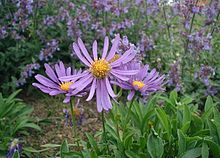- Aster (genus)
-
Aster Aster alpinus Scientific classification Kingdom: Plantae (unranked): Angiosperms (unranked): Eudicots (unranked): Asterids Order: Asterales Family: Asteraceae Tribe: Astereae Genus: Aster
L.Species Many, see text.
Aster (syn. Diplopappus Cass.) is a genus of flowering plants in the family Asteraceae. The genus once contained nearly 600 species in Eurasia and North America, but after morphologic and molecular research on the genus during the 1990s, it was decided that the North American species are better treated in a series of other related genera. After this split there are roughly 180 species within the genus, all but one being confined to Eurasia.[1] The name Aster comes from the Ancient Greek word ἀστήρ (astér), meaning "star", referring to the shape of the flower head. Many species and a variety of hybrids and varieties are popular as garden plants because of their attractive and colourful flowers. Aster species are used as food plants by the larvae of a number of Lepidoptera species — see list of Lepidoptera that feed on Aster. Asters can grow in all hardiness zones.
The genus Aster is now generally restricted to the Old World species, with Aster amellus being the type species of the genus, as well as of the family Asteraceae. The New World species have now been reclassified in the genera Almutaster, Canadanthus, Doellingeria, Eucephalus, Eurybia, Ionactis, Oligoneuron, Oreostemma, Sericocarpus and Symphyotrichum, though all are treated within the tribe Astereae. Regardless of the taxonomic change, all are still widely referred to as "asters" in the horticultural trades. See the List of Aster synonyms for more information.
In the UK there are only two native members of the genus: Goldilocks, which is very rare, and Aster tripolium, the Sea aster. Aster alpinus spp. vierhapperi is the only species native to North America.[1]
Some common species are:
- Aster alpinus, Alpine Aster
- Aster amellus, European Michaelmas Daisy or Italian Aster
- Aster linosyris, Goldilocks Aster
- Aster pringlei
- Aster scaber
- Aster sibiricus
- Aster subulatus Hairless Fleabane
- Aster tataricus, Tatarian Aster
- Aster tongolensis
- Aster tripolium, Sea Aster
Some common North American species that have now been moved are:
- Aster breweri (now Eucephalus breweri), Brewer's Aster
- Aster cordifolius (now Symphyotrichum cordifolium), Blue Wood Aster
- Aster dumosus L. (now Symphyotrichum dumosum) (L.) G. L. Nesom, New York Aster
- Aster divaricatus (now Eurybia divaricata), White Wood Aster
- Aster ericoides (now Symphyotrichum ericoides), Heath Aster
- Aster laevis (now Symphyotrichum laeve), Smooth Aster
- Aster lateriflorus (now Symphyotrichum lateriflorum), Lady in Black, Calico Aster
- Aster novae-angliae (now Symphyotrichum novae-angliae), New England Aster
- Aster novi-belgii (now Symphyotrichum novi-belgii), New York Aster
- Aster peirsonii (now Oreostemma peirsonii), Peirson's Aster
- Aster pilosus (now Symphyotrichum pilosum), Frost Aster
- Aster scopulorum (now Ionactis alpina), Lava Aster
The China aster is in a related genus, Callistephus.
Hybrids:
- Aster x frikartii (Aster amellus x A. thomsonii) Frikart's aster[2]
The Aster Revolution
The Hungarian revolution of 31 October 1918, became known as the "Aster Revolution" due to protesters in Budapest wearing this flower[citation needed].
References
- ^ a b Brouillet, Luc; Barkley, Theodore M.; Strother, John L. (2006), "Astereae", in Flora of North America Editorial Committee, eds. 1993+, Flora of North America, 20, New York & Oxford: Oxford University Press, pp. 3, http://www.efloras.org/florataxon.aspx?flora_id=1&taxon_id=20538
- ^ Floridata: Aster x frikartii
External links
- Ontario Wildflowers website Lots of info about Asters
- Pictures of Aster flowers thriving in the autumn sunshine
Categories:- Aster
- Garden plants
- Flowers
- Asteraceae genera
Wikimedia Foundation. 2010.






